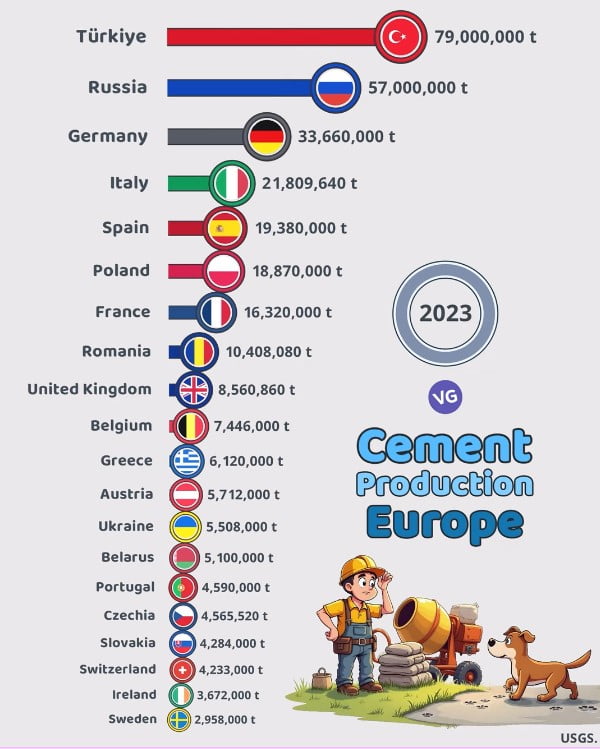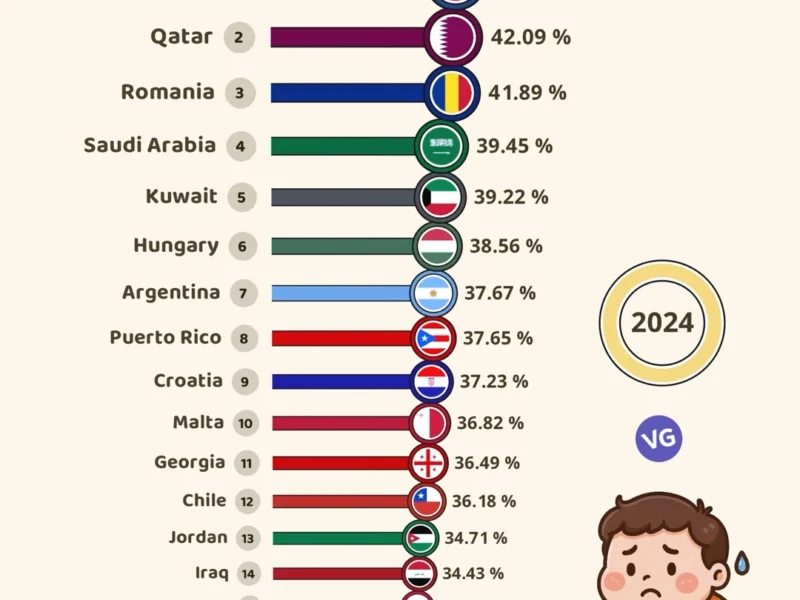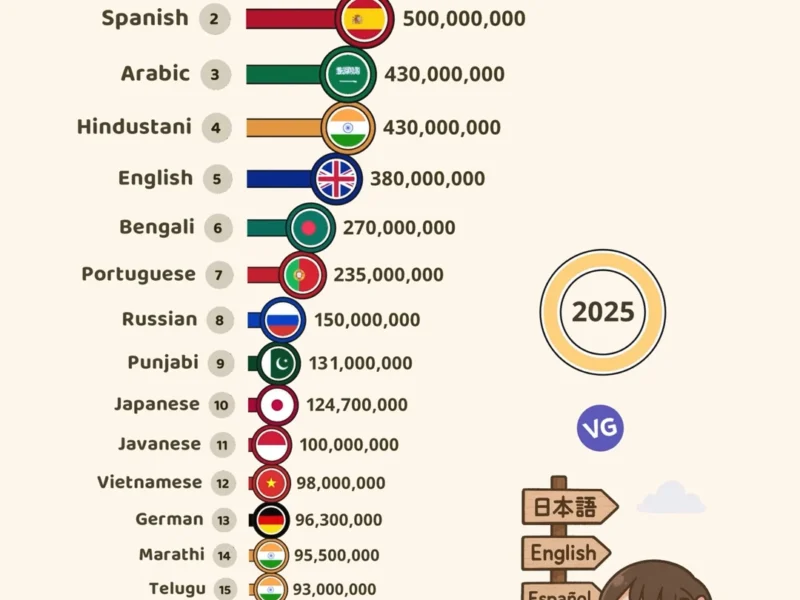In Europe, a few big companies lead the cement industry. They have big production and work all over the region1. Lafarge from France, HeidelbergCement from Germany, Holcim from Switzerland, Italcementi from Italy, and Cemex from Mexico are at the top. Together, they make over 1 billion tonnes of cement every year1.
The Largest Cement Producers in Europe 2023
| Country | Flag | Cement Production (tons) |
|---|---|---|
| Türkiye | 🇹🇷 | 79,000,000 |
| Russia | 🇷🇺 | 57,000,000 |
| Germany | 🇩🇪 | 33,660,000 |
| Italy | 🇮🇹 | 21,809,640 |
| Spain | 🇪🇸 | 19,380,000 |
| Poland | 🇵🇱 | 18,870,000 |
| France | 🇫🇷 | 16,320,000 |
| Romania | 🇷🇴 | 10,408,080 |
| United Kingdom | 🇬🇧 | 8,560,860 |
| Belgium | 🇧🇪 | 7,446,000 |
| Greece | 🇬🇷 | 6,120,000 |
| Austria | 🇦🇹 | 5,712,000 |
| Ukraine | 🇺🇦 | 5,508,000 |
| Belarus | 🇧🇾 | 5,100,000 |
| Portugal | 🇵🇹 | 4,590,000 |
| Czechia | 🇨🇿 | 4,565,520 |
| Slovakia | 🇸🇰 | 4,284,000 |
| Switzerland | 🇨🇭 | 4,233,000 |
| Ireland | 🇮🇪 | 3,672,000 |
| Sweden | 🇸🇪 | 2,958,000 |
The cement industry in Europe has seen tough times lately because of the economic crisis. But it’s still key for building and infrastructure2. The cement market was worth USD 363.67 billion in 2022 and will grow to USD 544.55 billion by 20302. The Asia Pacific region is leading with 75.2% of the market2. These leading companies in Europe are ready to meet the region’s building and infrastructure needs.
Major European Cement Manufacturers
The European cement industry has big players that shape the construction scene. Lafarge, from France, and HeidelbergCement, from Germany, are two big names3.
Cement Production in Europe (2023)
Source: USGS
.
.
Lafarge (France)
Lafarge is a giant in cement making, producing 205 million tonnes a year from 134 plants worldwide3. It’s big in Europe, known for its innovation and focus on being green. This makes it a leader in the cement world.
HeidelbergCement (Germany)
HeidelbergCement is another big name in Europe, based in Germany. It makes 90 million tonnes of cement a year from 100 plants3. This company is among the top in Europe and a big deal in cement making.
Lafarge and HeidelbergCement are top cement makers in Europe. They help build and improve infrastructure across the continent. Their big production and well-placed plants make them key in the cement industry.
| Company | Headquarters | Cement Production Capacity (million tonnes/year) | Number of Cement Plants |
|---|---|---|---|
| Anhui Conch | China | 217 | 26 |
| Lafarge | France | 205 | 134 |
| Holcim | Switzerland | 174 | 117 |
| HeidelbergCement | Germany | 90 | 100 |
| Italcementi | Italy | 80 | 60 |
This table shows how much cement Europe makes and the big roles of companies like Lafarge and HeidelbergCement3. They lead the pack in cement making in Europe.
“The cement industry is capital intensive, with costs of building plants above €150 million per million tonnes of annual capacity.”4
The cement industry in Europe has big challenges like high CO2 emissions and rules to follow. But Lafarge and HeidelbergCement are tackling these with new ideas and green practices4.
The Largest Cement Producers in Europe
The cement industry in Europe is very competitive. Many top producers are growing and changing to meet new market needs5. The biggest cement producers include Lafarge, HeidelbergCement, Holcim, Italcementi, and Cemex. They make the most cement and have the most cement plants in Europe5.
HeidelbergCement is a top cement producer from Germany. They make cement, ready-mixed concrete, and other building materials5. Lafarge is known for making special cement that is good for the planet5. The Aalborg Portland Group and Cementir Holding are also big names in cement production in Europe5.
The cement industry in Europe is key for building and infrastructure in the region5. But, it has to work on being less harmful to the environment. Concrete is a big source of CO₂ emissions, second only to water6. To help, European cement companies are looking into new ways to capture and use CO₂ emissions6.
| Cement Producer | Headquarters | Key Initiatives |
|---|---|---|
| HeidelbergCement | Germany | Leilac project for CO₂ capture, collaboration with Linde for large-scale CCU facility, CCS implementation in Norway plant |
| Lafarge | France | Specialized sustainable construction cement products |
| Holcim | Switzerland | Over 50 CCUS projects globally, aiming to capture 5 million tons of CO₂ annually by 2030 |
| Buzzi Unicem | Italy | CLEANKER and HERCCULES projects for CO₂ capture and conversion |
| Titan Cement | Greece | HERCCULES project for CO₂ capture and storage, IFESTOS initiative |
| Cementir | Italy | CCS pilot project in Denmark to capture CO₂ emissions |
| CRH Group | Ireland | K6 EQIOM project for cleaner air |
These top cement producers in Europe are investing in new technologies and operations. They want to lessen their environmental impact and support building projects5. The cement industry in Europe is key to making the future of buildings sustainable5.

Conclusion
The European cement industry is key to building and fixing things in the region. Big names like Lafarge, HeidelbergCement, Holcim, Italcementi, and Cemex lead the way7. In 2022, the construction market grew by 3%, but it’s expected to drop in 2023 and 20247. The industry wants to cut carbon emissions by a lot, aiming for a big reduction by 20307.
Even with challenges, the cement industry is vital for Europe’s move to a carbon-neutral economy8. It’s finding new ways to make cement and using waste as fuel, helping the planet8. Cement and concrete are also key for building things like wind turbines and dams, and they can be recycled8.
The European cement industry must keep changing and finding new ideas to stay ahead7. With the right rules and support, it can lessen its environmental harm and help make a sustainable future for cement and building in Europe8.
FAQ
What are the largest cement producers in Europe?
The biggest cement makers in Europe are Lafarge from France, HeidelbergCement from Germany, Holcim from Switzerland, Italcementi from Italy, and Cemex from Mexico. This info comes from the Global Cement Directory 2013 and 2014 research.
What are the cement production capacities and number of cement plants of the major European cement manufacturers?
Lafarge, in France, is a top cement producer with 205 million tons a year capacity and 134 plants. HeidelbergCement, from Germany, is also big with 90 million tons a year capacity and 100 plants.
How does the European cement industry landscape look like?
Lafarge, HeidelbergCement, Holcim, Italcementi, and Cemex lead the European cement market. They have big production capacities and many cement plants. The industry faces challenges but is key for building and infrastructure in Europe.
What are the key characteristics of the European cement industry?
The European cement market is very competitive. Top companies keep growing and changing to meet market needs. Cement is vital for building and infrastructure in Europe. These companies must innovate to stay ahead.
What are the potential growth opportunities for the European cement industry?
As European construction changes, cement producers must adapt and innovate. Their role in building and infrastructure is key for growth and development.
Source Links
- 10 Largest Cement Companies in the World – https://www.constructionkenya.com/5390/largest-cement-companies-world/
- Top 10 Cement Companies, 2024: A Brief Overview – https://www.fortunebusinessinsights.com/blog/top-cement-companies-worldwide-10975
- Top 75 global cement companies – https://www.globalcement.com/magazine/articles/822-top-75-global cement companies
- European cement producers show strength – https://www.aggbusiness.com/ab10/feature/european-cement-producers-show-strength
- List of Cement Suppliers in Europe – https://www.ezilon.com/business/building_materials/cement/index.shtml
- Top 10 Cement Companies in Europe to Use Carbon Nanotubes from CO₂ Emissions in 2030 – UP Catalyst – https://upcatalyst.com/top-10-cement-companies-in-europe-to-use-carbon-nanotubes-from-co₂-emissions-in-2030/
- The cement industry in Europe at the crossroads – Cement Lime Gypsum – https://www.zkg.de/en/artikel/the-cement-industry-in-europe-at-the-crossroads-4019235.html
- PDF – https://cembureau.eu/media/kuxd32gi/cembureau-2050-roadmap_final-version_web.pdf



